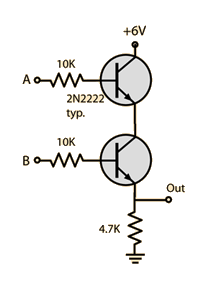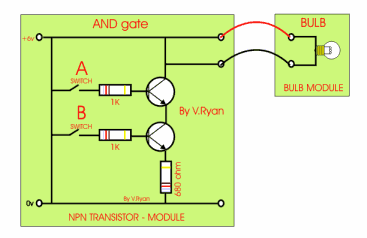

DivideByZero
-
Posts
85 -
Joined
-
Last visited
Content Type
Profiles
Forums
Events
Posts posted by DivideByZero
-
-
one more thing...
Do I need any of the resistors?
or can I just build it without the resistors?
0 -
Will this be guaranteed to work?
 0
0 -
Hi, I want to make a simple AND logic gate using transistors.
I found this diagram:

I believe it is using 2 NPN transistors to make an AND logic gate.
I've been trying to make a simple gate with two switches but I'm failing miserably.
The transistor I bought looks like this:

I just can't figure out where the ground end goes and how the switches are wired to the battery. Can someone please help me out? Can someone draw out a diagram including the power source for this AND gate with the two switches and a light bulb?
I've tried many times but can't figure out why the light bulb won't turn on when both switches are down. :evil:
thank you so much in advance.
I also found this circuit board online:

In that diagram I don't know where the power source comes in. Also what connects to that node in the bottom right??
Help!
0 -
No.
Potential difference (voltage) is not the same as electric field. You will need to use the potential difference and the geometry of the plates to calculate the electric field.
oh so i have to use E=V/d
and add the vectors...
0 -
If I were you I'd write down the force due to an electric field to start with...
You should probably be familiar with the lorentz force
http://en.wikipedia.org/wiki/Lorentz_force
Or at least a very simplified version of it for a charge in a uniform electric field...
electric field:
E = F/q
E * q = F
(480)(q) = F
holy s*** thanks for that hint!
Merged post follows:
Consecutive posts mergedOK so here is what I've done so far:
F_g = m*g = (0.00004kg)*(9.8) = 3.92e-4
F_e = E*q = (480)*(q)
F_t = m*g*cos(20) = 3.684e-4
F_g + F_e + F_t = 0
...
q = 1.58e-6
is this right?????
0 -
This is a hw problem so please explain your process instead of telling me the whole answer, thanks!

There is a conductive ball hanging from a string in a electric plate.
As you can see its slightly tilted toward the negative end.
mass of ball: 0.04g
potential difference: 480V
separation of plates: 0.06m
angle of string hanging: 20 degrees
the question asks: What is the charge of the ball?
I drew a free body diagram of three forces.
one: force of tension
two: gravity/weight
three: force of charge pointing towards the right
I think I'm suppose to add up the three forces to equal zero.
F1 + F2 + F3 = 0.
I think F3 should use the formula ©(q1)(q2)/(r^2). Am I right?
If so then what is r???
I'm so lost in this problem please help guys!
0 -
the inner and outer cores are conductive(being made primarily out of metal). if you take a nice big conductor(like the core) and spin it(also like the core) you get a magnetic field.
Don't you first need an electric current?
0 -
Oh,
how do rotating inner and outer cores create a magnetic field?
0 -
Does it just exist?
Any precise reason?
Why is there a magnetic field on earth?
0 -
I guess what I'm talking about is that it blinks on and off as fast as theoretically possible. Maybe on then off then on at Planck's time constant (smallest unit of time).
If the light was on and suddenly, within the smallest unit of time, it blinks off then on again, we wouldn't notice it.
And same thing the other way.
If the light was off and suddenly, within the smallest unit of time, it blinks on then off again, we wouldn't notice it.
So what happens if it blinks on and off repetitively as fast as possible?
0 -
If light were to blink on and off and the speed of light continuously, would the light appear to be on or off?
0 -
Oh my! Thank you guys so much!!!!
0 -
Well, I'd like to build my own as oppose to buy one. How hard can it be to build an OR gate anyways?
I'm mainly doing this for educational purposes. Once I get used to it, I might start buying pre-made logic gates.
I really want to make my own! Help!
0 -
How can I make AND, OR, XOR, and NOT logic gates in an electric current.
The power source could be a battery and I can connect parts using a copper wire.
But how can I make these logic gates? Whats the simplest way?
0 -
My god, it's full of stars.
Thanks!!! I can finally sleep now!!!!!!
0 -
Hey, I can't remember one quote from the movie "2001 a space odyssey". I'm hoping you guys can help me out.
I think the person who says it is Dave. It goes something like "So many colors!" or "my god! the colors are everywhere!"
it might have been during the ending scene where things stop making sense. Please help - its been bugging me for so long lol. What is the exact quote and who is it by?
0 -
So can a reaction of a metal (Zinc) with an acid (HCl) be classified as corrosion where the Zn looses mass?
Merged post follows:
Consecutive posts mergedBump!
0 -
Does corrosion require oxygen and water?
I know rusting (a form of corrosion) requires H2O and O2
but corrosion in general is just an oxidation-reduction reaction, right?
0 -
Check you denominator. Are you doing:
[H3AsO4] - [H+]
Because, once the H3AsO4 deprotonates, it no longer counts as a reactant. So however much deprotonates needs to be subtracted from the initial concentration of H3AsO4.
YESS!!!!! I LOVE YOU MAN!!!!!!!!!!!!!!!!!!!!!! HEARTS ALL AROUND!!!!
thank you everyone!!!!
0 -
I though it should be [H+]^2
because the concentration of the H+ and H3AsO4 should be equal in a weak acid. But even after I compute the answer, I keep getting it wrong.
0 -
woah woah woah!!
I though it was
[math]
K_a = \frac{[C^c][D^d]}{[A^a][b^b]}
[/math]
if so, then it should be
[math]
K_a = \frac{[H+]^2}{[H_3 AsO_4]}
[/math]
0 -
Ok. First of all this is a homework problem so please provide your steps on how you solved this.
Calculate the [math]K_{a}[/math] for the following acids using the given information.
(a) 0.220 M solution of H3AsO4, pH = 1.50
so i know the concentration of H+ ions would be 10^-1.5 = 0.0316 M
I think the dilution of the H3AsO4 is:
H3AsO4 --> 3H + AsO4
now what?
0 -
wouldn't wearing those 4 blocks of magnets under you feet on a magnetic rink hurt your feet? The opposite pole of the magnet would overcome your feet's manipulative skills if you tilt you feet just a bit.
0 -
I want to hook them to my (or anyone else's) brain and see the activity of each section of my brain on my computer.

I'm just interested in the brain but don't want to take biology because I don't want to study ecology, etc. I'm definitely going to take some course in neurology in grad school.
0

Electric Circuit Logic
in Physics
Posted
Oh My God it worked!!!!!!!!!
Thank you so much Miguel!!!!! You're the best! +rep!!
Thank you thank you thank you thank you!